
Combined arms is an approach to warfare that seeks to integrate different combat arms of a military to achieve mutually complementary effects—for example, using infantry and armour in an urban environment in which each supports the other.
Military strategy is a set of ideas implemented by military organizations to pursue desired strategic goals. Derived from the Greek word strategos, the term strategy, when first used during the 18th century, was seen in its narrow sense as the "art of the general", or "'the art of arrangement" of troops. and deals with the planning and conduct of campaigns, the movement and disposition of forces, and the deception of the enemy.

Prince Pyotr Ivanovich Bagration was a Russian general and prince of Georgian origin, prominent during the Napoleonic Wars.

The pincer movement, or double envelopment, is a military maneuver in which forces simultaneously attack both flanks (sides) of an enemy formation. This classic maneuver is important throughout the history of warfare.
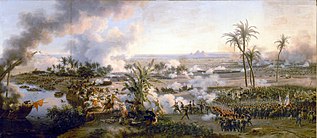
The Battle of the Pyramids, also known as the Battle of Embabeh, was a major engagement fought on 21 July 1798, during the French Invasion of Egypt. The battle took place near the village of Embabeh, across the Nile River from Cairo, but was named by Napoleon after the Great Pyramid of Giza visible nearly 9 miles away.

A counterattack is a tactic employed in response to an attack, with the term originating in "war games". The general objective is to negate or thwart the advantage gained by the enemy during attack, while the specific objectives typically seek to regain lost ground or destroy the attacking enemy.

Maneuver warfare, or manoeuvre warfare, is a military strategy which seeks to shatter the enemy's overall cohesion and will to fight.
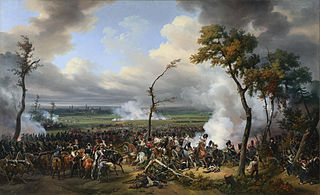
The Battle of Hanau was fought from 30 to 31 October 1813 between Karl Philipp von Wrede's Austro-Bavarian corps and Napoleon's retreating French during the War of the Sixth Coalition.

Encirclement is a military term for the situation when a force or target is isolated and surrounded by enemy forces. The situation is highly dangerous for the encircled force. At the strategic level, it cannot receive supplies or reinforcements, and on the tactical level, the units in the force can be subject to an attack from several sides. Lastly, since the force cannot retreat, unless it is relieved or can break out, it must fight to the death or surrender.

A rout is a panicked, disorderly and undisciplined retreat of troops from a battlefield, following a collapse in a given unit's command authority, unit cohesion and combat morale.

The Battle of Abukir was a battle in which Napoleon Bonaparte defeated Seid Mustafa Pasha's Ottoman army on 25 July 1799, during the French campaign in Egypt. It is considered the first pitched battle with this name, as there already had been a naval battle on 1 August 1798, the Battle of the Nile. No sooner had the French forces returned from a campaign to Syria, than the Ottoman forces were transported to Egypt by Sidney Smith's British fleet to put an end to French rule in Egypt.
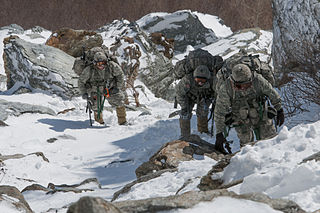
Mountain warfare or alpine warfare is warfare in mountains or similarly rough terrain. The term encompasses military operations affected by the terrain, hazards, and factors of combat and movement through rough terrain, as well as the strategies and tactics used by military forces in these situations and environments.
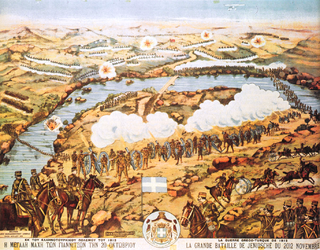
The Battle of Yenidje, also transliterated as Yenice, was a major battle between Greek forces under Crown Prince Constantine and Ottoman forces under General Hasan Tahsin Pasha and took place between October 19–20 (O.S.), 1912 during the First Balkan War. The battle began when the Greek army attacked the Ottoman fortified position at Yenidje, which was the last line of defense for the city of Thessaloniki.
Deep operation, also known as Soviet Deep Battle, was a military theory developed by the Soviet Union for its armed forces during the 1920s and 1930s. It was a tenet that emphasized destroying, suppressing or disorganizing enemy forces not only at the line of contact but also throughout the depth of the battlefield.

In military tactics, a flanking maneuver is a movement of an armed force around an enemy force's side, or flank, to achieve an advantageous position over it. Flanking is useful because a force's fighting strength is typically concentrated in its front, therefore, to circumvent an opposing force's front and attack its flank is to concentrate one's own offense in the area where the enemy is least able to concentrate defense.

The Aviation Squadrons of the Ottoman Empire were military aviation units of the Ottoman Army and Navy. The history of Ottoman military aviation dates back to June 1909 or July 1911. The organisation is sometimes referred to as the Ottoman Air Force. The fleet size reached its apex in December 1916, when the Ottoman aviation squadrons had 90 airplanes. The Aviation Squadrons were reorganized as the General Inspectorate of Air Forces on 29 July 1918. With the signing of the Armistice of Mudros on 30 October 1918, the Ottoman military aviation effectively came to an end. At the time of the armistice, the Ottoman military aviation had around 100 pilots; 17 land-based airplane companies ; and 3 seaplane companies ; totalling 80 aircraft.
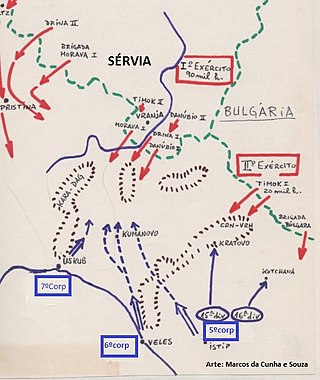
The Battle of Kumanovo, on 23–24 October 1912, was a major battle of the First Balkan War. It was an important Serbian victory over the Ottoman army in the Kosovo Vilayet, shortly after the outbreak of the war. After this defeat, the Ottoman army abandoned the major part of the region, suffering heavy losses in manpower and in war materiel.

The Ottoman Seventh Army was a large military formation of the Ottoman Empire in the late 19th and early 20th centuries. Although designated as an army, at least by 1918, it was only of corps strength.
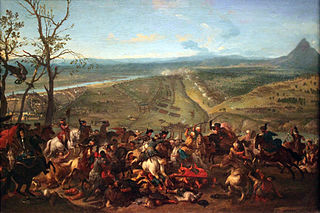
The siege of Belgrade was a successful attempt by Austrian troops under the command of Prince Eugene of Savoy to capture the strategically important city of Belgrade from the Ottoman Empire. It took place during the Seventh Ottoman–Venetian War (1714–1718), barely a year after the Austrian victory at the Battle of Petrovaradin (Peterwardein). The Austrians routed the Ottoman relief army under Grand Vizier Hacı Halil Pasha on 16 August. As a consequence, the Belgrade garrison, deprived of relief, surrendered to the Austrians on 21 August. The Ottoman Sultan Ahmed III sued for peace, resulting in the Treaty of Passarowitz a year later, which completed the transfer of the remainder of Hungary, the Banat and the city of Belgrade into Austrian hands.
Roman infantry tactics refers to the theoretical and historical deployment, formation, and manoeuvres of the Roman infantry from the start of the Roman Republic to the fall of the Western Roman Empire. The focus below is primarily on Roman tactics: the "how" of their approach to battle, and how it stacked up against a variety of opponents over time. It does not attempt detailed coverage of things like army structure or equipment. Various battles are summarized to illustrate Roman methods with links to detailed articles on individual encounters.
















